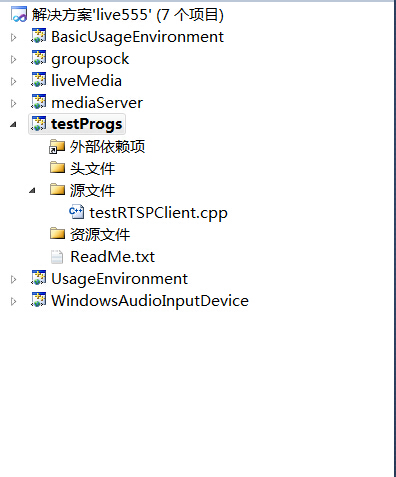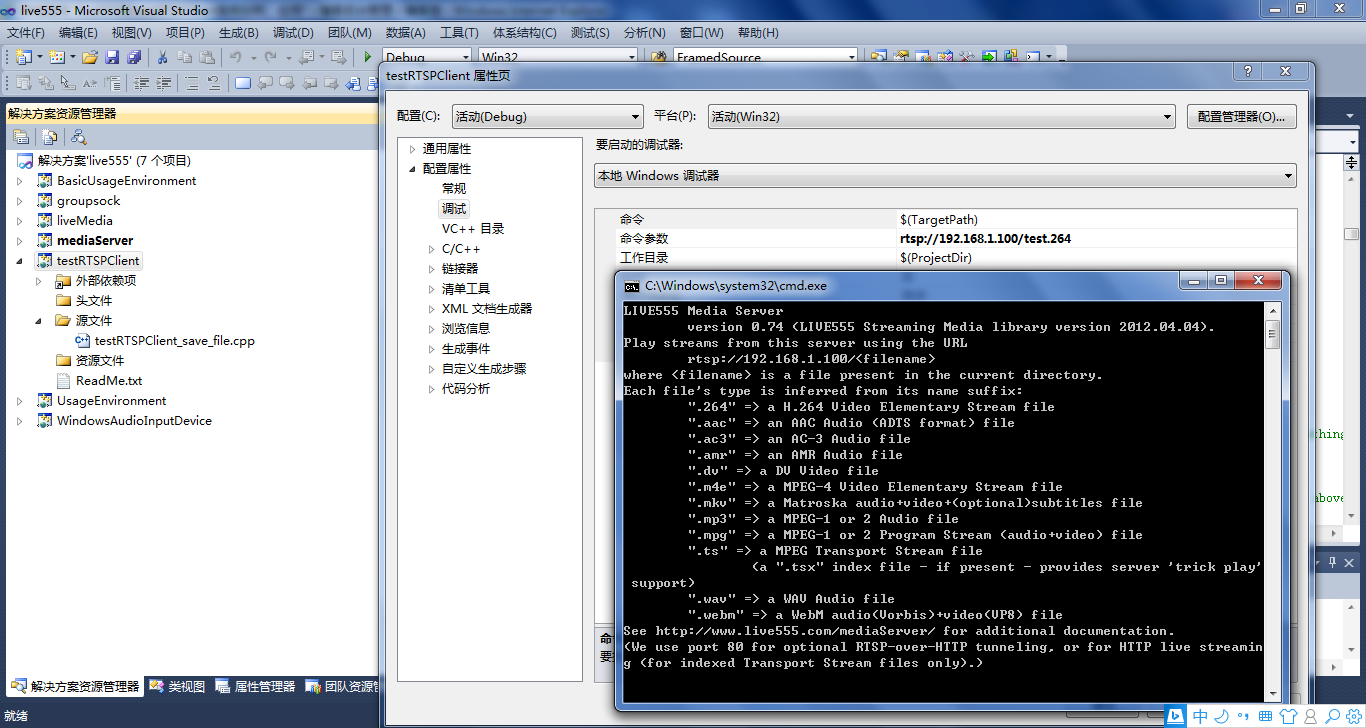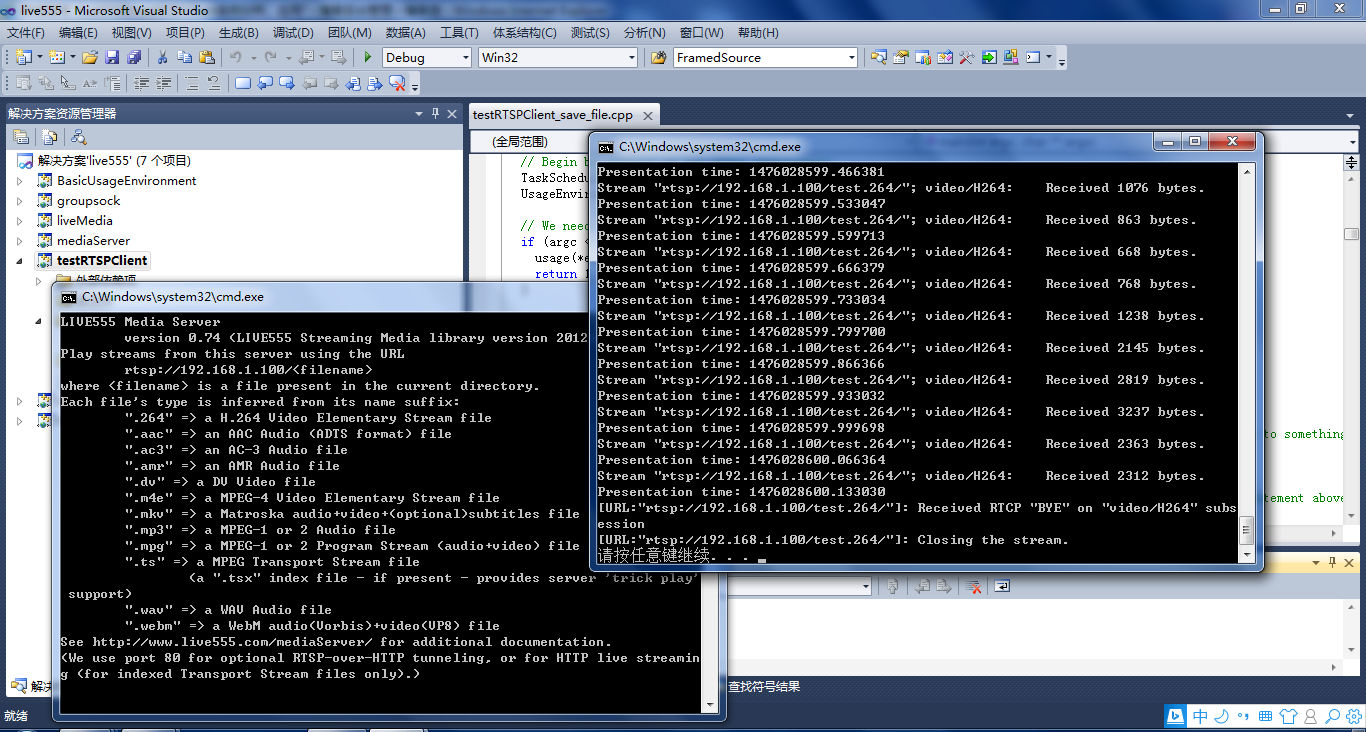live555库中的testRTSPClient实例
1、testRTSPClient简介
testRTSPClient是个简单的客户端实例,这个实例对rtsp数据交互作了详细的描述,其中涉及到rtsp会话的两个概念Source和Sink.
Source是生产数据,Sink是消费数据.
testRTSPClient非常简洁,除了接收服务端发送过来的数据,什么都没干,所以我们很方便在这个基础上改造,做我们自己的项目.
2、testRTSPClient编译,运行
在linux下编译运行更方便,鉴于我的电脑太渣,虚拟机跑起来费劲,就转到windows下来折腾.
在windows下只需要加载这一个文件就可以编译,我们以mediaServer为服务端,以testRTSPClient为客户端。
当然也可以用支持rtsp协议的摄像机或其他实体设备作为服务端。


先启动mediaServer,然后在testRTSPClient项目的命令菜单里填入mediaServer 提示的IP, 再启动testRTSPClient即可。


3、testRTSPClient核心代码解读
1)看代码之前可以大致浏览一下总体的框架,这位博主画了个流程图http://blog.csdn.net/smilestone_322/article/details/17297817
void DummySink::afterGettingFrame(unsigned frameSize, unsigned numTruncatedBytes,
struct timeval presentationTime, unsigned /*durationInMicroseconds*/) {
// We've just received a frame of data. (Optionally) print out information about it:
#ifdef DEBUG_PRINT_EACH_RECEIVED_FRAME
if (fStreamId != NULL) envir() << "Stream \"" << fStreamId << "\"; ";
envir() << fSubsession.mediumName() << "/" << fSubsession.codecName() << ":\tReceived " << frameSize << " bytes";
if (numTruncatedBytes > 0) envir() << " (with " << numTruncatedBytes << " bytes truncated)";
char uSecsStr[6+1]; // used to output the 'microseconds' part of the presentation time
sprintf(uSecsStr, "%06u", (unsigned)presentationTime.tv_usec);
envir() << ".\tPresentation time: " << (unsigned)presentationTime.tv_sec << "." << uSecsStr;
if (fSubsession.rtpSource() != NULL && !fSubsession.rtpSource()->hasBeenSynchronizedUsingRTCP()) {
envir() << "!"; // mark the debugging output to indicate that this presentation time is not RTCP-synchronized
}
envir() << "\n";
#endif // Then continue, to request the next frame of data:
continuePlaying();
} Boolean DummySink::continuePlaying() {
if (fSource == NULL) return False; // sanity check (should not happen) // Request the next frame of data from our input source. "afterGettingFrame()" will get called later, when it arrives:
fSource->getNextFrame(fReceiveBuffer, DUMMY_SINK_RECEIVE_BUFFER_SIZE,
afterGettingFrame, this,
onSourceClosure, this);
return True;
}
2)有网友在testRTSPClient基础上,把接收的数据写成h264文件了http://blog.csdn.net/occupy8/article/details/36426821
void DummySink::afterGettingFrame(void* clientData, unsigned frameSize, unsigned numTruncatedBytes,
struct timeval presentationTime, unsigned durationInMicroseconds) {
DummySink* sink = (DummySink*)clientData;
sink->afterGettingFrame(frameSize, numTruncatedBytes, presentationTime, durationInMicroseconds);
} // If you don't want to see debugging output for each received frame, then comment out the following line:
#define DEBUG_PRINT_EACH_RECEIVED_FRAME 1 void DummySink::afterGettingFrame(unsigned frameSize, unsigned numTruncatedBytes,
struct timeval presentationTime, unsigned /*durationInMicroseconds*/) {
// We've just received a frame of data. (Optionally) print out information about it:
#ifdef DEBUG_PRINT_EACH_RECEIVED_FRAME
if (fStreamId != NULL) envir() << "Stream \"" << fStreamId << "\"; ";
envir() << fSubsession.mediumName() << "/" << fSubsession.codecName() << ":\tReceived " << frameSize << " bytes";
if (numTruncatedBytes > 0) envir() << " (with " << numTruncatedBytes << " bytes truncated)";
char uSecsStr[6+1]; // used to output the 'microseconds' part of the presentation time
sprintf(uSecsStr, "%06u", (unsigned)presentationTime.tv_usec);
envir() << ".\tPresentation time: " << (unsigned)presentationTime.tv_sec << "." << uSecsStr;
if (fSubsession.rtpSource() != NULL && !fSubsession.rtpSource()->hasBeenSynchronizedUsingRTCP()) {
envir() << "!"; // mark the debugging output to indicate that this presentation time is not RTCP-synchronized
}
envir() << "\n";
#endif //todo one frame
//save to file
if(!strcmp(fSubsession.mediumName(), "video"))
{
if(firstFrame)
{
unsigned int num;
SPropRecord *sps = parseSPropParameterSets(fSubsession.fmtp_spropparametersets(), num);
// For H.264 video stream, we use a special sink that insert start_codes:
struct timeval tv= {0,0};
unsigned char start_code[4] = {0x00, 0x00, 0x00, 0x01};
FILE *fp = fopen("test.264", "a+b");
if(fp)
{
fwrite(start_code, 4, 1, fp);
fwrite(sps[0].sPropBytes, sps[0].sPropLength, 1, fp);
fwrite(start_code, 4, 1, fp);
fwrite(sps[1].sPropBytes, sps[1].sPropLength, 1, fp);
fclose(fp);
fp = NULL;
}
delete [] sps;
firstFrame = False;
} char *pbuf = (char *)fReceiveBuffer;
char head[4] = {0x00, 0x00, 0x00, 0x01};
FILE *fp = fopen("test.264", "a+b");
if(fp)
{
fwrite(head, 4, 1, fp);
fwrite(fReceiveBuffer, frameSize, 1, fp);
fclose(fp);
fp = NULL;
}
} // Then continue, to request the next frame of data:
continuePlaying();
} Boolean DummySink::continuePlaying() {
if (fSource == NULL) return False; // sanity check (should not happen) // Request the next frame of data from our input source. "afterGettingFrame()" will get called later, when it arrives:
fSource->getNextFrame(fReceiveBuffer, DUMMY_SINK_RECEIVE_BUFFER_SIZE,
afterGettingFrame, this,
onSourceClosure, this);
return True;
}
testRTSPClient接收的fReceiveBuffer缓存没有起始码,start_code[4] = {0x00, 0x00, 0x00, 0x01}; 写成文件或者播放都需要自行加上。
3)testRTSPClient这个实例还支持多路录放,网上搜到有人已经实现了,搬过来.
http://blog.chinaunix.net/uid-15063109-id-4482932.html
——缺什么补什么
live555库中的testRTSPClient实例的更多相关文章
- RTSP客户端接收存储数据(live555库中的testRTSPClient实例)
1.testRTSPClient简介 testRTSPClient是个简单的客户端实例,这个实例对rtsp数据交互作了详细的描述,其中涉及到rtsp会话的两个概念Source和Sink. Source ...
- live555库中的testH264VideoStreamer实例
1.h264文件的推送 testH264VideoStreamer.cpp文件的开头就定义了 char const* inputFileName = "test.264"; 后面接 ...
- live555库中的openRTSP实例
一.openRTSP编译运行 a)windows下编译运行 还是以mediaServer作为服务端,openRTSP作为客户端 b)Linux下编译运行 转自http://kuafu80.blog.1 ...
- RTSP客户端接收存储数据(live555库中的openRTSP实例)
一.openRTSP编译运行 a)windows下编译运行 还是以mediaServer作为服务端,openRTSP作为客户端 b)Linux下编译运行 转自http://kuafu80.blog.1 ...
- RTSP服务端转发服务(live555库中的testH264VideoStreamer.cpp和testOnDemandRTSPServer.cpp实例)
1.h264文件的推送 testH264VideoStreamer.cpp文件的开头就定义了 char const* inputFileName = "test.264"; 后面接 ...
- 宣布在 Azure 镜像库中正式推出 Windows Server 2012 R2 并降低 Windows Azure 的实例定价
我们今天将宣布两条消息,为使用基础结构服务的客户提供更多选择和成本节约:在镜像库中推出 Windows Server 2012 R2 以及降低 Memory Intensive 计算实例定价. 虚拟机 ...
- NSClassFromString 实例话静态库中的类
Class myClass = NSClassFromString("StaticLibyClassName"); StaticLibyClassName是从静态库中实例化一个Cl ...
- Solr的原理及在项目中的使用实例.
前面已经讲过 如果安装及配置Solr服务器了, 那么现在我们就来正式在代码中使用Solr.1,这里Solr主要是怎么使用的呢? 当我们在前台页面搜索商品名称关键词时, 我们这时是在Solr库中去查找 ...
- linux静态与动态库创建及使用实例
一,gcc基础语法: 基本语法结构:(由以下四部分组成) gcc -o 可执行文件名 依赖文件集(*.c/*.o) 依赖库文件及其头文件集(由-I或-L与-l指明) gcc 依赖文件集(*.c/*.o ...
随机推荐
- Linux_日志管理介绍(一)
一.介绍 1.CentOS 6.x中日志服务已经由rsyslogd取代了原先的syslogd服务,但是rsyslogd是和syslogd服务相兼容的 2.除了系统默认的日志之外,采用RPM方式安装的系 ...
- 【BZOJ 2434】【NOI 2011】阿狸的打字机 fail树
完全不会啊,看题解还看了好久,我是蒟蒻$QAQ$ $zyf$的题解挺好的:http://blog.csdn.net/clove_unique/article/details/51059425 $fai ...
- 【CodeForces 261B】Maxim and Restaurant(DP,期望)
题目链接 第一种解法是$O(n^3*p)$的:f[i][j][k]表示前i个人进j个人长度为k有几种方案(排列固定为123..n时).$f[i][j][k]=f[i-1][j][k]+f[i-1][j ...
- redis事务
当一个client在连接中发出multi命令时,这个连接就进入一个事务的上下文,该连接后续的命令不会执行,而是存放到一个队列中,当执行exec命令时,redis会顺序的执行队列中的所有命令.如果其中执 ...
- OPENGL的入门第一个程序——Hello World
#include "stdafx.h" #include<GL\glut.h> void Init() { glClearColor(0.0f,0.0f,0.0f,0. ...
- Jquery打叉怎么办
选中报错文件右键MyEclipse>Exclude From xxxx
- Bmob开发指南【android端】
作为一个开发者,数据的存储,用户的登陆,验证等操作,对程序来说是必不可少的,下面我们将从Bmob的基本信息开始讲起: [Bmob] 官网: http://www.bmob.cn/ 帮助文档:htt ...
- ecshop /includes/init.php Arbitrary User Login Vul
catalog . 漏洞描述 . 漏洞触发条件 . 漏洞影响范围 . 漏洞代码分析 . 防御方法 . 攻防思考 1. 漏洞描述 对用户输入的cookie,判断免登的逻辑中存在漏洞,导致黑客可以直接通过 ...
- TCP/IP详解 笔记十一
域名服务系统(DNS) DNS:名字到IP转换:电子邮件选路信息:分布式数据库 解析器:是通过gethostbyname(3)和gethostbyaddr(3)来实现的 最常用的名字服务器是BIND ...
- 解决“HTTP/1.1 405 Method not allowed”问题
Apache.IIS.Nginx等绝大多数web服务器,都不允许静态文件响应POST请求,否则会返回"HTTP/1.1 405 Method not allowed"错误. 即,将 ...
